Night photography is one of the most unique, challenging, and rewarding types of photography in the world. Recent cameras have the ability to capture stunning night landscapes in virtually no light. Shooting in the middle of the night is not quite as simple as picking up your camera and pressing the shutter button, there are many factors that need to be taken into account. In daylight there is much more light available to your camera sensor and its very easy to take for granted all the things your camera automatically does. If you have difficulty taking images at night, or have had experience shooting at night and would like to improve your images, here are my top 10 tips for night photography.

A slow shutter speed adds a sense of motion to the rides
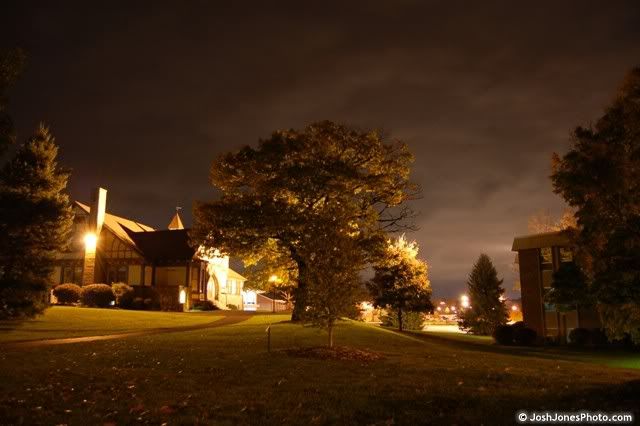
Overcast skies provide for an interesting sky at night
2) Use a long shutter speed - To experienced photographers this is an obvious, but very important setting. If your camera doesn't have a mode on it where you can adjust the shutter speed, see if you can increase the exposure compensation to force the camera to take in more light (generally the camera will use a longer shutter speed for you). Since light meters are often inaccurate at night, you may need to do some manual adjustments to your shutter speed to reach your desired result. By using a long shutter speed you also introduce the effect of motion in your images. Experiment using long shutter speeds on moving objects such as cars that leave light trails as they speed down the road.

A 30 second exposure captures the motion of the cars
3) Use a low ISO - Since you’re using a tripod, you don't have to worry about camera shake anymore. Your shutter can stay open as long as necessary. Most cameras have the option to adjust the sensitivity of the image sensor (ISO). By turning the sensitivity down, you reduce the amount of noise that the camera will introduce into your image. This is especially important when using long shutter speeds as the noise builds up the longer the sensor is capturing image data. Using an ISO such as 100 or 200 will provide detailed, clean images.
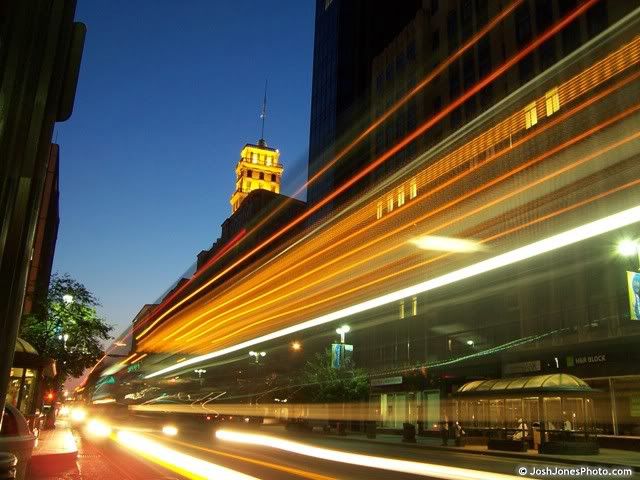
Shooting just after sunset gives a deep blue sky
4) Use a wide angle lens - In night landscape photography it’s important to capture all the interesting types of lighting that are present. By using a wide angle lens you accomplish three important things. First, you can include both the main subject as well as the details in the foreground and sky. Second, you usually end up including several different types of light such as sodium vapor lamps, moon light, and incandescent street lights. All these types of light have different color temperatures and can add an interesting color contrast to your picture. Thirdly, using a wide angle lens minimizes many focusing issues because the construction of short focal length lenses yields a large depth of field. Have interesting night photos been taken with telephoto lenses? Sure they have! Look though some of your favorite night landscape images and I bet you that many of them will be taken with wide, or ultra wide angle lenses.
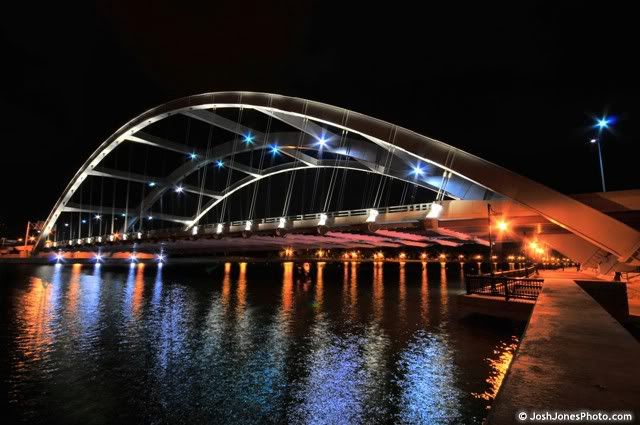
A wide angle lens adds to the perspective
5) Stop down that aperture - Stopping down the aperture of your camera gives many benefits in night photography. First, it helps to minimize any focusing errors because your depth of field is larger (especially when combined with a wide angle lens). Second, it usually brings your lens into the range where it is most sharp (usually 1-2 stops past wide open). Thirdly, by using a small aperture such as f/10 or f/14, you may notice that stars appear around the light sources. This is only of my favorite effects in night photography. The number of points on the starbursts is determined by your lens construction. Lenses with more blades on their aperture give starbursts with more points. In addition, using a smaller aperture allows you to use longer shutter speeds that build more motion into your image.
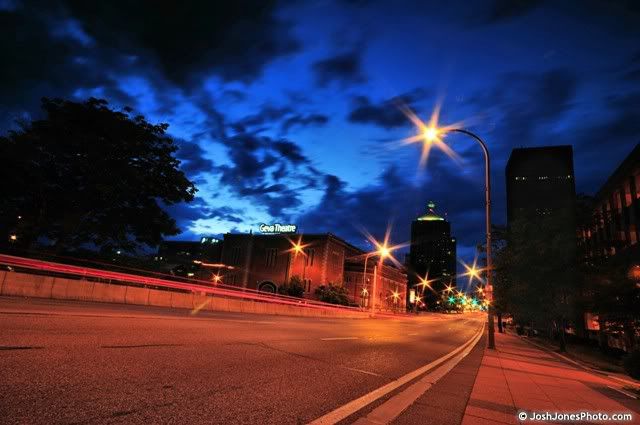
Starbursts add an interesting touch to this image
6) Use self timer or mirror up mode - I lied a bit when I told you that tripods totally get rid of all camera shake. The act of pressing the shutter down and taking your hand off the camera creates camera shake as well. The mirror slapping up into position on SLR cameras can also create camera shake. Thankfully, you can get around these issues in several ways. The simplest way is to use the self timer, by doing this you ensure that you will have no effect on the camera shaking because any shake you caused will be gone before the camera fires. Another way is to use a mirror up mode, or exposure delay mode that delays the mirror activation and lessens the likelihood of its motion softening your image. Another great way to rid camera shake is to use a cable release. Some cameras have available infrared shutter remotes, which are generally fairly cheap and effective. Some cameras can accept cable releases that do the same task. Here is a money saving tip, don't waste your money on the expensive cable releases made by your camera manufacturer, the cheap 3rd party ones work great!

The contrasting foreground, midground, and background elements add to this composition.
7) Control your auto focus - Sometimes it is tough to get your camera to autofocus at night. If you have selectable autofocus points, I'd recommend placing one directly over a light source. The light source gives a place for your autofocus system to detect contrast in the scene, and set the focus correctly. If your lens has manual focus capabilities, positioning it at infinity works in most landscape images.
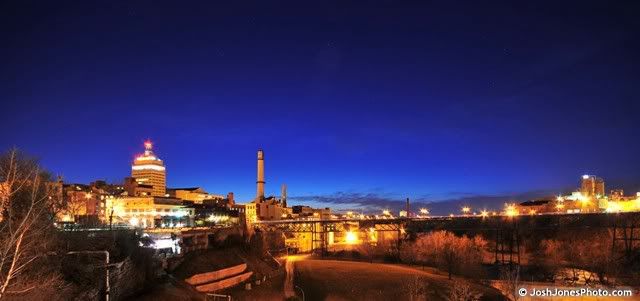
The contrasting blue and gold colors make this landscape interesting
8) White balance is your friend - Getting the colors right in night pictures can often be difficult. I usually use an incandescent white balance to ensure my picture doesn't look like someone spilled yellow dye all over it. Street lamps at night usually have a yellow tint to them that can spoil your image. Another option to fix this problem is to set a custom white balance. Take a picture of something that should be color neutral. If you have a white card, sheet of paper, or white or gray shirt laying around then you have a perfect object to take your white balance reference picture off. Sometimes it's not always possible to get exactly the right colors when you're out shooting. By shooting in RAW the image you capture still maintains all the white balance information and allows you to manipulate it later. I usually set a custom white balance as I'd rather nail the shot when I'm out shooting rather than spending time behind the computer fixing it later.

This image was taken with a zoom lens to compress the scene
9) Try different angles - Try getting really close up to the things you are shooting, or placing interesting things in the foreground. Because you’re using a tripod means that it is going to be very tempting to shoot things at eye-level. Unfortunately, this is usually the most boring perspective you can shoot from. Try retracting the legs on your tripod so you’re shooting from only a foot or two off the ground. Try getting on top of something tall and shooting from a very high perspective.
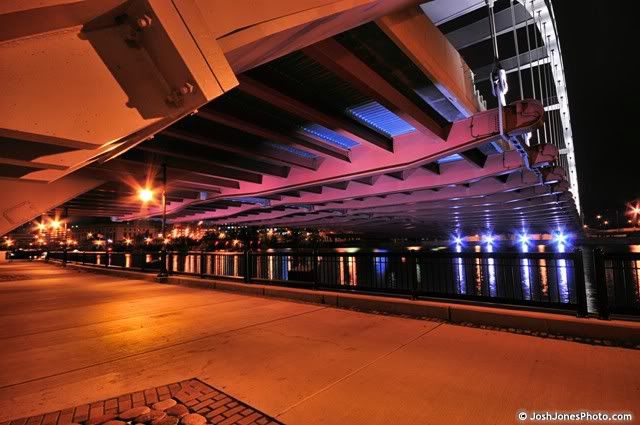
Getting below this bridge shows a unique angle
10) Shoot during the right time of night - Shooting during the golden hour can give you some incredible results. Instead of having a dull black sky, by shooting just after sunset, you will be rewarded with a rich blue sky. The deep cool sky makes for a really interesting color contrast with the yellow hue of street lamps or fall trees. Another great time to shoot is when it is slightly windy with partly cloudy skies. The wind pushes the clouds across the sky as the image is being exposed and creates interesting streaks across the sky of your image. Experimenting with ultra long exposures (5+ minutes) on clear skies can also show the motion of the stars in the sky.

The blue sky contrasts against the fall colors of the tree
I hope these 10 tips can help you out. A lot of great images can be made by experimenting with your own settings and equipment. Don't expect to master it all in one night. I've been shooting night images for many years and I can tell you first hand that this type of photography is a constant learning experience but can provide you with some absolutely stunning images. Your creativity is the limit, get out there tonight and shoot!




Great Post Josh ... Thanks for sharing!
ReplyDeleteJosh thanks a lot for putting this up. One question, when you say stop up, should i increase be increasing the aperture number? So shooting on a F10 is better than F5.6 at night? Now that i look most night shots dont go for that depth of field like in day shots.
ReplyDeleteThanks for the kind words over on my Wordpress blog. You've got some great shots here. I hope I can keep progressing and get better.
ReplyDeleteThanks
Signed,
Will Mahoney
From one photographer to another, great tips. And yes, distractions are amazing!
ReplyDelete